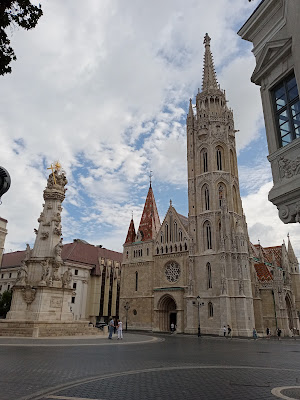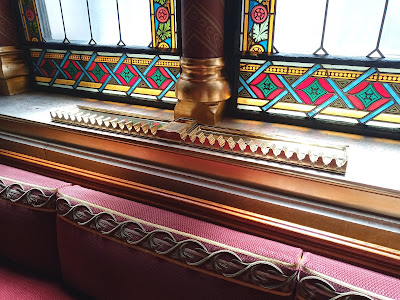Early morning really is the best part of the day to explore, before the hotels and more importantly the river cruise boats disgorge their tourists for the day. Although I am not really a morning person I did get up early today to travel over to the Buda side of the city for a look around the Castle Hill district before it awoke.
The Fishermans Bastion was built in the late 19th century as a promenade, a walking area overlooking Pest and the River Danube. It still serves this purpose to this day giving amazing views across the city but commands an entrance fee from 9am until 9pm. If, however, you get their around 8am like I did, then you can admire the views for free and with no crowds.
 |
| Fishermans Bastion |
 |
| View of the Danube and Parliament building from Buda |
 |
| View of the Chain Bridge from Buda |
Just behind the Fishermans Bastion is the brightly coloured roof of the Matthais Church, in which the last two kings of Hungary were crowned - highly decorated inside, it is worth the admission cost but again gets crowded so go early. Buda is really is a lovely part of the city with cobbled streets to just stroll and admire the views.
The first bridge across the River Danube connecting Buda and Pest was the Szechenyi or Chain Bridge. Designed by Bristolian William Tierney Clark in 1839. It is basically just a bigger version of Clark's other bridge - across the Thames in Marlow - which served as a prototype.
 |
| It looks at its best lit up at night |
The big ticket sight to see in Budapest (on the Pest side of the river) is the parliament building, for which it is best to book in advance online as when I went for my pre booked 12 noon visit, all tickets for today had already sold out. Note also, there is a dual pricing system in place, one price for EU citizens and one price for non EU. They advertise it as a discout for EU citizens but in reality non EU citzens are charged double. It is worth visiting, but it is expensive.
 |
| The Parliament also looks good floodlit from across the River Danube |
The building was designed and the political system modelled on the Palace of Westminster and government in London. Hence there many similarities when you look at the building. It was built around the turn of the 20th century and for a bicameral form of government - two houses - following the British, House of Lords and House of Commons model. Remember Hungary at that point was part of the dual-monarchy Austro-Hungarian Empire with the Emperor of Austria also being King of Hungary. The building is therefore symmetrical. After World War I, Hungary was declared a republic and goverment became unicameral - one house - and therefore a large part of the building is no longer used regularly, which is what you see on the visits.
 |
| Grand Staircase |
The tour takes in three main areas - The grand staircase, the area under the central dome and the former upper chamber. Under the central dome in a secure glass case guarded by two soldiers are the Hungarian Crown Jewels - crown, orb, septure and sword. (No photos allowed)
The Holy Crown of Hungary is famous for the fact the cross on the top is bent at an angle. The general theory for this is that at some point in its history when it was being hiden for security reasons it was hastily placed in a chest incorrectly and the lid closed damaging the crown inside. Despite being a republic, the crown is revered by Hungarians as the symbol of their nationhood having been used to crown monarchs since the 12th century. |
| Former Upper Chamber |
 |
| Former Upper Chamber |
Outside the debating chambers there are a series of these racks, with one numbered place for each member to leave his cigar in while he went into the smoke free chamber. Whilst I don't recall seeing something similar in the London, you just know don't you that the idea must have come from Britain!












No comments:
Post a Comment